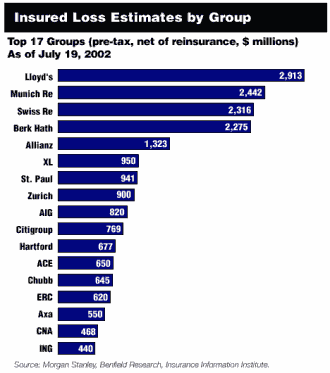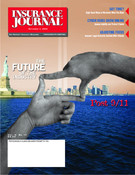When the nation awoke on the morning of Tuesday, Sept. 11, little did it know that the events over the next few hours would change its lives forever.
Not only were there thousands of lives lost and injured, but many more had their futures changed forever. Not escaping both the financial and emotional pain was the insurance industry. Aon and Marsh combined lost more than 400 hard-working, dedicated employees. The industry also took a major financial hit and is still attempting to recover.
In planning out this issue like many other magazines and newspapers, Insurance Journal wanted to bring its readers an update on where the industry is both financially and from a human standpoint.
Not only was it important to look at how the industry has bounced back financially, but also to update the goings-on in the battle between leaseholder Larry Silverstein and more than 20 insurers, the latest on the terrorism bill, how commercial property and workers’ comp were impacted and the unfortunate fraud that surfaced with the events of Sept. 11.
All of us grew as both an industry and a nation that day and from there on. Over these eight pages, Insurance Journal takes a look back at Sept. 11 and how the industry has changed a year later.
On Sept. 11, 2001, terrorists hijacked two American Airlines jets and one United Airlines jet and flew them into the buildings that stood as the epitome of freedom for the U.S.—the Twin Towers of the World Trade Center and the Pentagon. A fourth United jet crashed into the Pennsylvania countryside, averting its target, widely believed to be the White House.
Financial Recovery in the Reinsurance Industry Post 9/11
Among the repercussions—most significantly, the loss of approximately 3,000 human lives—family, friends, colleagues and loved ones—the resilient reinsurance industry immediately stretched to it’s limits upon realization of the massive loss it was about to sustain.
“The terrorist attacks of September 11, 2001 produced insured losses larger than any natural or man-made event in history,” Robert Hartwig, Ph.D., senior vice president and chief economist of the Insurance Information Institute (I.I.I.) recently stated in his analysis “September 11, 2001: The First Year.”
“Total life and non-life insurance losses are expected to reach at least $40 billion,” added Hartwig. “The losses sustained by the insurance industry were unprecedented in virtually every respect, producing catastrophic losses not only in property coverages, but also for the first time in life insurance, disability and workers’ compensation lines. Aviation and liability insurers also suffered their worst-ever losses stemming from a single event.”
“September 11th changed the insurance world entirely,” said Irmgard Wallner, press officer at Munich Re. “Claims reached dimensions which had previously never been considered possible.”
According to statistics supplied by I.I.I., Morgan Stanley and Benfield Research, Lloyd’s of London sustained the greatest amount of losses from the attacks at $2,913 billion, as of July 19, 2002. Munich Re and Swiss Re followed close behind with losses of $2,442 billion and $2,316 billion, respectively. U.S.-based reinsurers The St. Paul Companies and American International Group Inc. suffered respective losses of $941 million and $820 million.
So how did the major reinsurers fare financially months, almost one year after the Sept. 11 attacks?
Lloyd’s of London
Lloyd’s of London released its first-ever annually accounted results for 2001 on April 10, 2002, noting no new significant change to losses arising from Sept. 11. The original estimate of Sept. 26, 2001 showed Lloyd’s net exposure arising from the attacks at UK 1.3 billion (US $1.9 billion), equivalent to 12 percent of the market’s 2001 capacity. The $1.9 billion estimate was increased to $1.98 billion on Nov. 27, 2001.
“Clearly it [the attack on America] was the biggest claim we’ve ever had to deal with,” Adrian Beeby, spokesperson for Lloyd’s, told Insurance Journal. “It’s our largest single loss of all time. It was also the most complex claim we’ve had to deal with, and we’re still dealing with, and I suspect we’ll be dealing with for probably another 5 to 10 years at least.
“Immediately post World Trade Center we saw actual premium income going up very dramatically,” said Beeby. “Certain risks simply doubled overnight. There was a much greater flow of premium into the market.”
In April 2002, Lloyd’s reported a total loss of UK 3.11 billion for 2001, reflecting not only the Sept. 11 attacks, but also the Air Lanka fleet attack, and losses in the energy market due to the Petrobras oil rig off the coast of Brazil and an explosion at the Toulouse plant in France.
Lloyd’s chief executive Nick Prettejohn commented on the results in a press release, saying, “2001 was an exceptional year by any measure. Our loss is large in absolute terms, but relative to other major property and casualty insurers the Lloyd’s combined ratio of 140 percent was comparable to the performance of our global peer group.
“The state of the Lloyd’s market today is very positive,” added Prettejohn. “Capacity is at an all time high, and we are seeing significant improvements in trading conditions across all lines of business. The last six months have seen an estimated increase in premium income of nearly two thirds, compared with the same period a year ago. These increases give us confidence that 2002, in absence of any extraordinary catastrophes, should see the return to profitability for the Lloyd’s market.”
Lloyd’s completed a transfer of over $5 billion to U.S. trust funds in Aug. 2002, meeting U.S. regulatory requirements relating to claims arising from the terrorist attacks. To date, Lloyd’s has received over 3,200 claims and has already paid over $1.4 billion on reported claims, primarily from U.K. trust funds.
“We were required to transfer billions of dollars fairly quickly into those trust funds,” said Beeby. “That did give us a problem. But ultimately, once we really got into early 2002 and the transfer of funds was completed, the situation stabilized at Lloyd’s.”
Munich Re
Munich Re responded to the financial impact of Sept. 11 by adding $500 million to its provisions for losses that may be incurred long term from the terrorist attacks in July of 2002, “which is now estimated and reserved at $2.63 billion,” according to Wallner.
“As to be expected, the figures of Munich Re Group for the year 2001 as a whole had been heavily impacted by the loss of the terrorist attack of September 11th. The balance sheet reflects the huge loss in New York,” added Wallner. Of the $2.63 billion in provisions, Wallner said only a small part of the total sum has been paid out so far.
However, Munich Re remains optimistic about the future of the market. “There is an upward trend in the global reinsurance market,” said Wallner. “After 11th September purchasers and providers of insurance cover have at last become aware of the new risk dimensions. The trend towards risk-adequate prices and conditions in reinsurance intensified appreciably in the most recent treaty renewals. Munich Re’s competitive position has been further enhanced. The Group’s solidity and security are more sought after than ever.
“But Sept. 11 also clearly showed how the capitol markets react to major loses: share prices fell dramatically and led to strong reductions in regular investment income, lower net realized capital gians, higher writedowns and significant redutions in valuation reserves,” added Wallner. Munich Re did report first quarter 2002 premium income up 37.8 percent to EUR 6.9 billion, compared to first quarter results in 2001.
Swiss Re
Swiss Re’s 2001 annual report, released in April 2002, sustained a net loss of CHF 165 million (U.S. $110,185,908) for 2001, compared to net income in the prior year of CHF 296 million. The loss was primarily due to the financial impact of Sept. 11 and a reduction in capital gains. Furthermore, Swiss Re reported the combined ratio in the Property & Casualty Business Group deteriorated from 117 percent to 124 percent due to the impact of losses from Sept. 11. Excluding the loss, the underlying combine ratio was 110 percent.
In a letter from chairman Peter Forstmoser and CEO Walter Kielholz, Swiss Re’s outlook for 2002 was aptly defined. “Looking beyond the 11 September event, it is encouraging to see that Swiss Re strengthened its competitive position throughout the year 2001. In spite of adverse events and unsatisfactory overall results, Swiss Re is now in an excellent position to capitalize on improving markets and achieve superior results in the coming years.”

The St. Paul Companies
Recently released second quarter 2002 results for The St. Paul Companies showed a net loss of $223 million, or $1.09 per diluted share, including the previously announced $380 million after-tax impact of its settlement of the Western MacArthur litigation in June 2002. Operating loss was at $193.8 million, or $0.95 per diluted share.
“We’re pleased with the overall progress we have made on our strategic and operating initiatives,” said Jay Fishman, chairman and CEO in a press release. “Pricing gains continue, we continue to generate profitable new business, and we are comfortable with retention rate trends. Our expense initiatives are having a real impact.”
The Companies reported a net loss of $1.09 billion in 2001, compared with a net income of $993 million for 2000. The result includes more than $600 million in after-tax losses due to the financial impact of Sept. 11, as well $612 million after-tax for reserve strengthening, restructuring charges and the write-down of goodwill, primarily related to The St. Paul’s planned exit of the medical malpractice business and most of the company’s international operations.
American International Group
American International Group Inc. (AIG) reported that its net income for the second quarter of 2002 increased 37.0 percent to $1.80 billion, compared to $1.31 billion in the second quarter of 2001. Second quarter adjusted income for 2002, excluding net realized capital gains (losses) and the cumulative effect of accounting changes and acquisition, restructuring and related charges in 2001, increased 9.8 percent to $2.21 billion.
Rebounding from the aftermath of the terrorist attacks, AIG chairman Maurice Greenberg stated in a press release, “AIG had a solid quarter. Our core insurance and financial services businesses achieved satisfactory results that were partially offset by lower investment income. Even with lower net investment income attributable primarily to market and credit conditions, we achieved strong results from our General Insurance operations…. Also this quarter, we incurred net realized capital losses of $629 million, including $356 million in WorldCom securities.
“Rates are going up after a decade of price declines and policy form inflation,” he added. “Many companies have been weakened by this period of extremely competitive pricing. The losses following September 11 further ensure a continuing firming of the market for a foreseeable future. The trend toward firmer pricing is most evident in the U.S. where soft market conditions had been most pronounced and proacted. However, it is also apparent in markets around the world.”
Recovery for the future
Sept. 11 has forever changed the insurance industry in so many different aspects, from the immeasurable loss of human life in friends and colleagues, to the financial impact on the world’s largest reinsurers. In the years to come, reinsurers and the insurance industry as a whole will eventually fully recover from the financial impact of Sept. 11, but not before a few good lessons have been learned.
Dr. Hans-Jürgen Schinzler, chairman of Munich Re’s Board of Management, reiterated the role of reinsurance in a press release months after the attacks. “The terrorism losses in the USA, as well as other major losses, demonstrate how much primary insurers continue to need reinsurance as a risk-transfer vehicle to guarantee their own claims-paying ability when faced with extreme financial burdens. This also highlights the question of reinsurers’ security—their financial strength and claims-paying ability. Primary insurers will take a very close look at their reinsurers in future to be sure they can rely on having their claims paid even when the going gets tough.”
Topics Catastrophe USA Profit Loss Excess Surplus Reinsurance Market Lloyd's London AIG
Was this article valuable?
Here are more articles you may enjoy.


 Florida Class Action Targets Litigation Funding Firm Over Data Breach
Florida Class Action Targets Litigation Funding Firm Over Data Breach  Pet Insurance, Agents Gets a Shorter Leash Under Bill DeSantis Signed Into Law
Pet Insurance, Agents Gets a Shorter Leash Under Bill DeSantis Signed Into Law  More Floridians Moving Out Due to Housing, Insurance Costs, Cotality Report Says
More Floridians Moving Out Due to Housing, Insurance Costs, Cotality Report Says  South Florida Insurance Broker Pleads Guilty to Fraud in $133M ACA Enrollment Scheme
South Florida Insurance Broker Pleads Guilty to Fraud in $133M ACA Enrollment Scheme 


